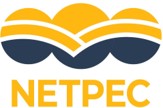NETPEC stands for “Negative Emission Technologies based on PhotoElectroChemical Methods” and is a collaborative research project funded by the BMBF. The overall goal of the NETPEC project is the development of highly efficient photoelectrochemical approaches to convert carbon dioxide into easily storable, safe and sustainable carbon sink products. This is accompanied by climate modeling, geological reservoir investigations and sustainability analysis, thus making the NETPEC project follow a holistic approach.

(https://doi.org/10.1002/aenm.202103801)

(left) STC efficiency and module area required under Sahara irradiance for a selection of products at 50 % system loss. Error bars indicate 40 % and 60 % loss, respectively.
(right) Module area for formic acid production over the yearly irradiance at 50 % (solid line), as well as 40 % and 60 % (dashed lines) system loss. Vertical lines mark typical irradiances accessible to a two-axis tracker.
(https://doi.org/10.5194/esd-10-1-2019)
Photoelectrochemistry uses semiconductors to transform the photon energy of
absorbed sunlight into an electrochemical potential difference, which is then used for converting carbon dioxide into a specific sink product. This method, also referred to as artificial photosynthesis, is typically used for the generation of energy-rich fuels such as hydrogen or hydrocarbons at efficiencies that are about one order of magnitude higher than in natural photosynthesis. Artifical photosynthesis can, however, also be used for the synthesis of carbon-rich products that are optimized for carbon-sink efficiency and longterm storage. The NETPEC consortium has already outlined first routes and benchmarking criteria for high-efficiency carbon sinks that have the potential to be used for the transformation of carbon dioxide into non-gaseous, stable compounds. When compared to negative emission approaches based on natural photosynthesis, a negative emission technology based on photoelectrochemistry could reduce the required land area and water consumption by several orders of magnitude, thus largely avoiding land use conflicts with e.g. food production. In principle, a variety of sink products are possible and candidate materials have to be chosen according to storage criteria and achievable efficiencies. However, the most carbon-sink efficient products deviate from those currently investigated for solar fuels from carbon dioxide. Therefore, novel catalysts, light absorbers, and product handling approaches have to be developed.
The following institutions are members of the NETPEC consortium: Ulm University (A. Groß), University of Tübingen (M. May, K. Rehfeld), Technical University of Darmstadt (K. Reiter), Karlsruhe Institute of Technologie (A. Patyk), University of Stuttgart (M. Saliba), and Helmholtz Centre Berlin (P. Bogdanoff).





